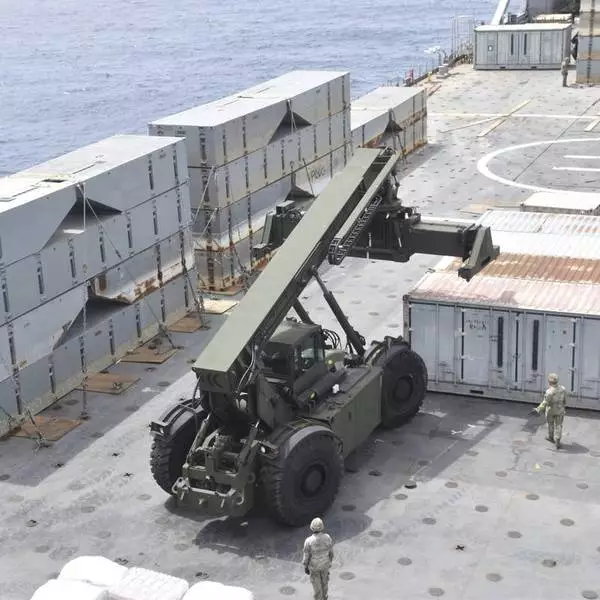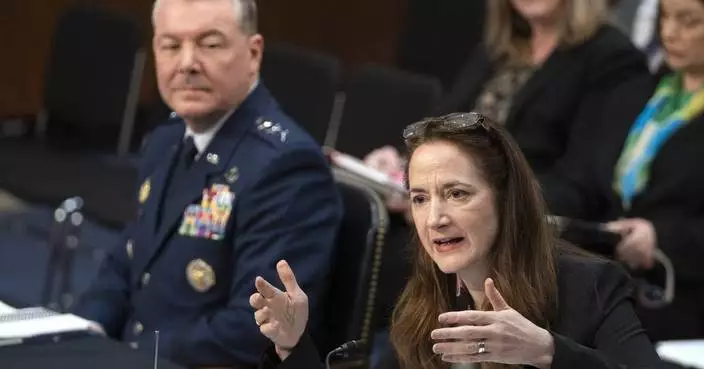The golf-and-politics alliance between President Donald Trump and Sen. Lindsey Graham frayed Wednesday over Syria, with the South Carolina Republican threatening to become the White House's "worst nightmare" unless more is done to protect Kurdish fighters against Turkish attacks.
Trump, in turn, suggested Graham focus on his job leading the Senate Judiciary Committee and reminded him who's in a position to threaten whom.
"I am the boss," Trump said.
Asked whether he could still work with Trump, Graham huffed, "I don't care right now."
It was a striking change in one of Trump's most unlikely Washington partnerships, part of a broader rupture with congressional Republicans who increasingly struggle to defend the president's foreign policy. That's generally not been a challenge for Graham, at least since the 2016 election. Throughout Trump's time in office, Graham has modeled the technique of flattering and supporting the president where possible and saying he "disagrees" with him at other times.
Their falling out may not last long, as Graham has publicly disagreed with Trump before only to return to the fold. And Trump has reason to preserve ties, as Graham has become a useful ally — something he can't spare as he tries to hold GOP support against possible impeachment by the House. Graham in recent weeks had been on the airwaves defending him on that.
The relationship between the two men is walking proof at how successful Trump has been at bending the Republican Party to his will. The two men clashed repeatedly during the early stages of the 2016 campaign, with Graham declaring that the brash New York businessman was unfit for the post he sought. Trump accused the senator of Beltway hypocrisy, at one point even reading out his cell phone number at a rally.
But after that November's stunning result, Graham began to cozy up to the new president. And Trump let him.
For the president, having Graham as an ally opened a conduit to the establishment in the Republican Senate. Graham was willing to provide ardent support for the White House's doomed efforts to overturn "Obamacare."
It was during those negotiations that the two men began to forge a friendship and Trump told confidants that he was surprised and appreciative of the senator's willingness to aggressively defend him on television — something few other Republican senators seemed willing to do with any consistency, according to three White House officials and Republicans close to the president who are not authorized to discuss private conversations.
Trump has observed that Graham's eagerness to attach himself to the president was likely to ward off a possible primary challenge from the right, a testament to the power of his base. But Graham's willingness to break with his longtime friend, Sen. John McCain — whom Trump loathed — to frequently side with Trump also delighted the president, his allies said. And the president still praises Graham's aggressive defense of Brett Kavanaugh during last year's Supreme Court confirmation hearings. Trump has mused that he needs more "energy" like that from other Republicans, according to the officials.
All that recent professed goodwill seemed to crumble when the White House announced Oct. 6 that Trump was withdrawing U.S. forces from protecting the Syrian Kurds, clearing the way for a brutal invasion by the Turks. Trump's move was a stick in the eye of the hawkish senator who had acted as something of a presidential educator on foreign policy. Three years after raging against the former New York developer for being unqualified for the presidency, Graham was back to hammering Trump.
Syria, Graham tweeted, was "the biggest mistake of his presidency" and made Trump no better than President Barack Obama. The move would help ISIS break the prisons the Kurds have been guarding, Graham said. And if there is another terrorist attack, he said, it's on Trump.
Then Graham, who is up for reelection next year, launched a vague threat against a president fond of retaliating against his critics.
"I will do anything I can to help him, but I will also become President Trump's worst nightmare," Graham told Pat Robertson on TV's "The 700 Club" in remarks broadcast Wednesday. "To President Trump, if you're listening to this interview, if you remove all of our forces from Syria, you're throwing the Kurds over, ISIS will come back on your watch, and Iran will take over and you, my friend, will be in great jeopardy of losing the election."
Trump suggested Graham mind his own Senate business and his political fortunes, which Trump defined partly as defending Trump.
"I think Lindsey should focus on Judiciary," Trump said at the White House alongside Italian President Sergio Mattarella. "The people of South Carolina want to see those troops come home and I won an election based on that."
Politically, the threats are thin gruel, as neither man is in danger of losing South Carolina next year. Trump remains popular there, and Graham's outspokenness tracks with his campaign's announcement this week of record fund-raising — for the state and among Republican Senate candidates in this filing period.
But both men face blowback from their pasts. Trump is facing the House's impeachment inquiry over his pressure on Ukraine President Volodymyr Zelenskiy to investigate the Biden family, a matter that troubles many Republicans and is replayed daily as the House hauls in a different current or former administration official to testify on the subject.
And Graham is weathering criticism over his flip-flop for trashing Trump as a "nutjob" in 2016, only to turn around and embrace him as president. He's also got a past when it comes to impeachment. Graham, a former Air Force prosecutor, was among the House members most aggressively gunning for President Bill Clinton during impeachment proceedings in 1999.
Then a House prosecutor, Graham spoke from the well of the Senate to make the case: "Impeachment is not about punishment. Impeachment is about cleansing the office. Impeachment is about restoring honor and integrity to the office."
Now a senator, Graham seems to be part of the impeachment defense. Asked about whether Trump improperly asked Ukraine's leader to undermine a political opponent, Graham replied he had "zero problems with this phone call."
WASHINGTON (AP) — The U.S. military finished installing a floating pier for the Gaza Strip on Thursday, with officials poised to begin ferrying badly needed humanitarian aid into the enclave besieged over seven months of intense fighting in the Israel-Hamas war.
The final, overnight construction sets up a complicated delivery process more than two months after U.S. President Joe Biden ordered it to help Palestinians facing starvation as food and other supplies fail to make it in as Israel recently seized the key Rafah border crossing in its push on that southern city on the Egyptian border.
Fraught with logistical, weather and security challenges, the maritime route is designed to bolster the amount of aid getting into the Gaza Strip, but it is not considered a substitute for far cheaper land-based deliveries that aid agencies say are much more sustainable. The boatloads of aid will be deposited at a port facility built by the Israelis just southwest of Gaza City and then distributed by aid groups.
U.S. troops will not set foot in Gaza, American officials insist, though they acknowledge the danger of operating near the war zone.
Heavy fighting between Israeli troops and Palestinian militants on the outskirts of Rafah has displaced some 600,000 people, a quarter of Gaza’s population, U.N. officials say. Another 100,000 civilians have fled parts of northern Gaza now that the Israeli military has restarted combat operations there.
Pentagon officials said the fighting in Gaza wasn’t threatening the new shoreline aid distribution area, but they have made it clear that security conditions will be monitored closely and could prompt a shutdown of the maritime route, even just temporarily. Already, the site has been targeted by mortar fire during its construction and Hamas has threatened to target any foreign forces who “occupy” the Gaza Strip.
The “protection of U.S. forces participating is a top priority. And as such, in the last several weeks, the United States and Israel have developed an integrated security plan to protect all the personnel who are working," said Navy Vice Adm. Brad Cooper, a deputy commander at the U.S. military's Central Command. "We are confident in the ability of this security arrangement to protect those involved.”
U.S. troops anchored the pier at 7:40 a.m. local time Thursday, the military's Central Command said in a statement, which stressed that none of its forces entered the Gaza Strip.
“Trucks carrying humanitarian assistance are expected to begin moving ashore in the coming days,” the statement said. “The United Nations will receive the aid and coordinate its distribution into Gaza.”
It wasn't immediately clear which U.N. agency would be involved.
Israeli forces will be in charge of security on the shore, but there are also two U.S. Navy warships near the area in the eastern Mediterranean Sea, the USS Arleigh Burke and the USS Paul Ignatius. Both ships are destroyers equipped with a wide range of weapons and capabilities to protect American troops off shore and allies on the beach.
Aid agencies say they are running out of food in southern Gaza and fuel is dwindling, which will force hospitals to shut down critical operations and halt truck deliveries of aid. The United Nations and other agencies have warned for weeks that an Israel assault on Rafah, which is on the border with Egypt near the main aid entry points, would cripple humanitarian operations and cause a disastrous surge in civilian casualties.
More than 1.4 million Palestinians — half of Gaza’s population — have been sheltering in Rafah, most after fleeing Israel’s offensives elsewhere.
The first cargo ship loaded with 475 pallets of food left Cyprus last week to rendezvous with a U.S. military ship, the Roy P. Benavidez, which is off the coast of Gaza. The pallets of aid on the MV Sagamore were moved onto the Benavidez. The Pentagon said moving the aid between ships was an effort to be ready so it could flow quickly once the pier and the causeway were installed.
The installation of the pier several miles (kilometers) off the coast and of the causeway, which is now anchored to the beach, was delayed for nearly two weeks because of bad weather and high seas. The sea conditions made it too dangerous for U.S. and Israeli troops to secure the causeway to the shore and do other final assembly work, U.S. officials said.
According to a defense official, the Sagamore’s initial shipment was estimated to provide enough to feed 11,000 people for one month. The official spoke on the condition of anonymity to provide details not yet made public.
Military leaders have said the deliveries of aid will begin slowly to ensure the system works. They will start with about 90 truckloads of aid a day through the sea route, and that number will quickly grow to about 150 a day. But aid agencies say that isn't enough to avert impending famine in Gaza and must be just one part of a broader Israeli effort to open land corridors.
Biden used his State of the Union address on March 7 to order the military to set up a temporary pier off the coast of Gaza, establishing a sea route to deliver food and other aid. Food shipments have been backed up at land crossings amid Israeli restrictions and intensifying fighting.
Under the new sea route, humanitarian aid is dropped off in Cyprus where it will undergo inspection and security checks at Larnaca port. It is then loaded onto ships — mainly commercial vessels — and taken about 200 miles (320 kilometers) to the large floating pier built by the U.S. military off the Gaza coast.
There, the pallets are transferred onto trucks, driven onto smaller Army boats and then shuttled several miles (kilometers) to the floating causeway, which has been anchored onto the beach by the Israeli military. The trucks, which are being driven by personnel from another country, will go down the causeway into a secure area on land where they will drop off the aid and immediately turn around and return to the boats.
Aid groups will collect the supplies for distribution on shore, with the U.N. working with the U.S. Agency for International Development to set up the logistics hub on the beach.
Sabrina Singh, Pentagon spokeswoman, told reporters that the project will cost at least $320 million, including the transportation of the equipment and pier sections from the United States to the coast of Gaza, as well as the construction and aid delivery operations.
Associated Press writer Jon Gambrell in Dubai, United Arab Emirates, contributed to this report.

US military says Gaza Strip pier project is completed, aid to soon flow as Israel-Hamas war rages on

US military says Gaza Strip pier project is completed, aid to soon flow as Israel-Hamas war rages on

In this image provided by the U.S. Army, soldiers assigned to the 7th Transportation Brigade (Expeditionary) and sailors attached to the MV Roy P. Benavidez assemble the Roll-On, Roll-Off Distribution Facility (RRDF), or floating pier, off the shore of Gaza on April 26, 2024. The U.S. expects to have on-the-ground arrangements in Gaza ready for humanitarian workers to start delivering aid this month via a new U.S.-backed sea route for Gaza aid. An official with the U.S. Agency for International Development tells the AP that humanitarian groups expect to have their part of preparations complete by early to mid-month. (U.S. Army via AP)












